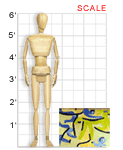VAM galleries including this work:
Clara M. Eagle Gallery, Murray State University | Animal Farm | Young at Art || VAM Home
Paul Klee (Swiss, 1879-1940)
THE YELLOW DONKEY, date unknown
Silkscreen; 25" X 20"
1958.002.00
Clara M. Eagle Gallery, Murray State University - (c) 2005 Artists Rights Society (ARS), New York / VG Bild-Kunst, Bonn
The Yellow Donkey, a silkscreen print by Paul Klee, showcases the artist’s trademark use of bold and unconventional color. The figures are reduced to simple shapes and lines and rest on a flat picture plane in a manner reminiscent of prehistoric paintings found in caves in Europe and Africa.
About the Artist
Considered one of the 20th century’s most important artists, Paul Klee created more than 10,000 works.
He was born in Münchenbuchsee, Switzerland, in 1879, the son of musicians. In addition to receiving a thorough classical education, Klee was trained on the violin beginning as a young boy. He ultimately decided that he wanted to focus his talents on visual art rather than music. In 1898, he left home to pursue his education in Munich, which was then a key location for avant-garde art. After a year of private lessons, he entered the Munich Academy, where he remained for two years. Klee then spent several years traveling in Italy and France before resettling in Munich in 1906.
Dissatisfied with his abilities as a painter, Klee focused the first half of his career on printmaking and drawing. But while traveling in Tunisia in 1914, he had an epiphany. Believing that he had finally come to understand the concept of light, from that time forward he considered himself a painter. After serving in the air force for some time, Klee was invited to teach at the Bauhaus School in 1920. He remained there until 1931, when he left to accept a position at the Düsseldorf Academy of Fine Arts. Less than two years later, a Nazi campaign against modern artists resulted in Klee’s dismissal from the academy, and he left Germany to return to Switzerland.
In 1935, Klee began to show symptoms of the disease that was to kill him, which was later recognized as scleroderma. Despite his deteriorating condition, Klee continued to paint. Nearly 20 of his works were included in Hitler’s derisive exhibit of Entartete Kunst, or “degenerate art,” which opened three years before Klee’s death in 1940.
In 2005, the Zentrum Paul Klee opened in Bern. Funded by a public-private partnership including the Klee family, the institution serves as an archive and center of excellence built around Klee’s life and work. Of the 10,000 or so works that make up Paul Klee’s oeuvre, about 40 percent, or around 4,000 paintings, watercolors, and drawings, as well as archives and biographical material, have been brought together at the Zentrum Paul Klee. The center’s holdings are considered the largest collection in the world devoted to a single artist of international renown.
Classroom Ideas
Discussion: How would you describe The Yellow Donkey? Do you think the artwork fits into a particular category? Does it remind you of work you’ve seen by other artists in the KVAM or elsewhere? Why or why not?
Activity: One person who had a significant influence on Klee was friend and fellow artist Wassily Kandinsky, whom Klee met in 1911. Using resources available at your local library or online, spend some time looking at and researching Klee’s and Kandinsky’s artworks. Write an essay about the two artists, explaining what their works have in common and how they differ. What are the distinguishing characteristics of each artist’s work?
Links
Visit the Zentrum Paul Klee for an extensive database of works and information about the artist.
[www.paulkleezentrum.ch/ww/en/pub/web_root.cfm]
Some more places to see images of Klee’s works:
- Detroit Institute of Art
[www.dia.org/asp/search/ExecuteSearch.asp?artist=Paul%20Klee] - Fine Arts Museums of San Francisco
[search.famsf.org:8080/search.shtml?keywords=paul+klee] - Guggenheim Museum
[www.guggenheimcollection.org/site/artist_works_75_0.html] - Metropolitan Museum of Art
[www.metmuseum.org/Works_of_Art/viewOne.asp?dep=21&viewMode=1&item=1987%2E455%2E2] - More museums are listed in the ArtCyclopedia.
[www.artcyclopedia.com/artists/klee_paul.html]
Read more about the life and art of Paul Klee at the WebMuseum.
[www.ibiblio.org/wm/paint/auth/klee/]
Klee curriculum resources are available at the Digital Palette.
[www.digitalpalette.org.uk/worcboxes/paul/index.html]
Learn about printmaking, step by step, at the Museum of Modern Art’s What Is a Print? site.
[www.moma.org/exhibitions/2001/whatisaprint/print.html]

